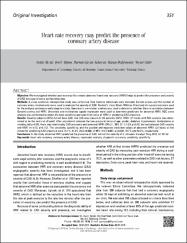| dc.contributor.author | Akyüz, Aydın | |
| dc.contributor.author | Alpsoy, Şeref | |
| dc.contributor.author | Akkoyun, Dursun Çayan | |
| dc.contributor.author | Değirmenci, Hasan | |
| dc.contributor.author | Güler, Niyazi | |
| dc.date.accessioned | 2022-05-11T14:40:08Z | |
| dc.date.available | 2022-05-11T14:40:08Z | |
| dc.date.issued | 2014 | |
| dc.identifier.issn | 2149-2263 | |
| dc.identifier.issn | 2149-2271 | |
| dc.identifier.uri | https://doi.org/10.5152/akd.2014.4824 | |
| dc.identifier.uri | https://hdl.handle.net/20.500.11776/8875 | |
| dc.description.abstract | Objective: We investigated whether post-exercise first minute abnormal heart rate recovery (HRR1) helps to predict the presence and severity of CAD, because of some confounding data. Methods: A cross-sectional, retrospective study was performed. Two hundred individuals were included. Gensini scores and the number of coronary artery involvements were used to evaluate the severity of CAD. Student's t-test, Mann-Whitney U test and chi-square test were used for the analysis continuous and categorical data. Spearman's correlation analysis was used to determine whether there is correlation between Gensini scoring and HRR1. Univariate and multivariate logistic regression were used to determine predictors for abnormal HRR1. ROC curve analysis was performed to detect the best sensitivity and specificity value of HRR1 in predicting CAD presence. Results: Seventy subjects (35%) did not have CAD, and CAD was present in 130 patients (65%). HRR1 <= 21 beats with ROC analysis was determined to be the best cut off point. After adjustment between the two groups in terms of age, gender, diabetes, hypertension, dyslipidemia or smoking (all p>0.05), there was relationship CAD presence and abnormal HRR1 (OR=2.1, 95% CI: 1.1-3.9, p=0.02), but not between CAD severity and HRR1 (r=-0.13, p=0.112). The sensitivity, specificity, and the positive and negative predictive values of abnormal HRR1 <= 21 beats at first minute for predicting CAD presence were 76.1%, 41.3% (AUC=0.588, CI 95%: 0.517-0,657, p=0.039), 70.7% and 48.3%, respectively. Conclusion: In the study abnormal HRR1 predicted the presence of CAD, but not the severity of it. | en_US |
| dc.language.iso | eng | en_US |
| dc.publisher | Aves | en_US |
| dc.identifier.doi | 10.5152/akd.2014.4824 | |
| dc.rights | info:eu-repo/semantics/closedAccess | en_US |
| dc.subject | heart rate recovery | en_US |
| dc.subject | coronary artery disease | en_US |
| dc.subject | regression analysis | en_US |
| dc.subject | diagnostic accuracy | en_US |
| dc.subject | sensitivity | en_US |
| dc.subject | specificity | en_US |
| dc.subject | Ventricular Systolic Dysfunction | en_US |
| dc.subject | Chronotropic Response | en_US |
| dc.subject | Treadmill Exercise | en_US |
| dc.subject | Mortality | en_US |
| dc.subject | Severity | en_US |
| dc.title | Heart rate recovery may predict the presence of coronary artery disease | en_US |
| dc.type | article | en_US |
| dc.relation.ispartof | Anatolian Journal of Cardiology | en_US |
| dc.department | Fakülteler, Tıp Fakültesi, Dahili Tıp Bilimleri Bölümü, Kardiyoloji Ana Bilim Dalı | en_US |
| dc.identifier.volume | 14 | en_US |
| dc.identifier.issue | 4 | en_US |
| dc.identifier.startpage | 351 | en_US |
| dc.identifier.endpage | 356 | en_US |
| dc.institutionauthor | Akyüz, Aydın | |
| dc.institutionauthor | Alpsoy, Şeref | |
| dc.institutionauthor | Akkoyun, Dursun Çayan | |
| dc.institutionauthor | Değirmenci, Hasan | |
| dc.institutionauthor | Güler, Niyazi | |
| dc.relation.publicationcategory | Makale - Uluslararası Hakemli Dergi - Kurum Öğretim Elemanı | en_US |
| dc.authorscopusid | 16315021800 | |
| dc.authorscopusid | 6505680586 | |
| dc.authorscopusid | 25225280400 | |
| dc.authorscopusid | 55810763400 | |
| dc.authorscopusid | 7005837198 | |
| dc.authorwosid | Alpsoy, Seref/Z-1808-2018 | |
| dc.identifier.wos | WOS:000338109400010 | en_US |
| dc.identifier.scopus | 2-s2.0-84903139645 | en_US |
| dc.identifier.pmid | 24818624 | en_US |



















